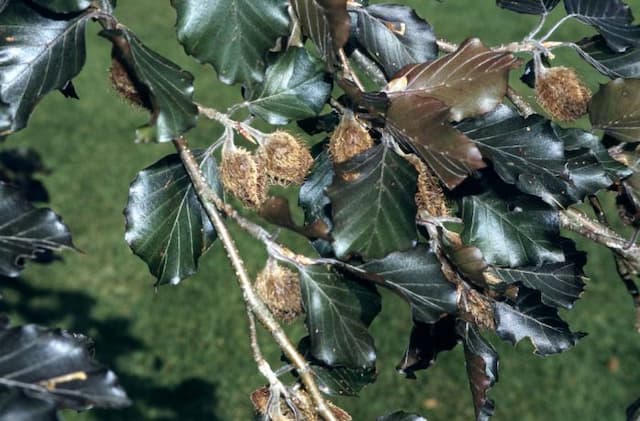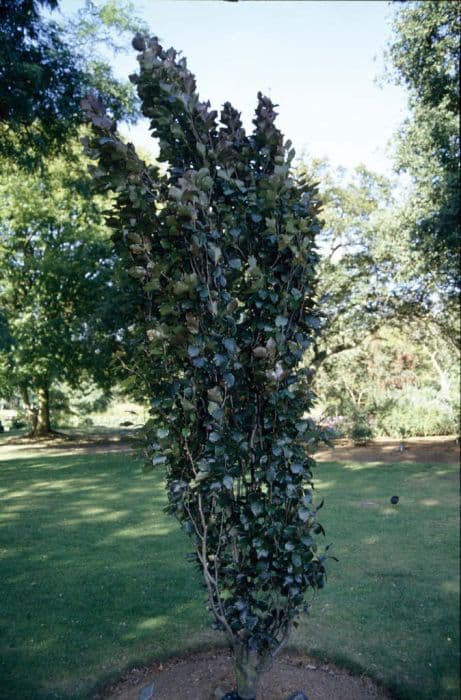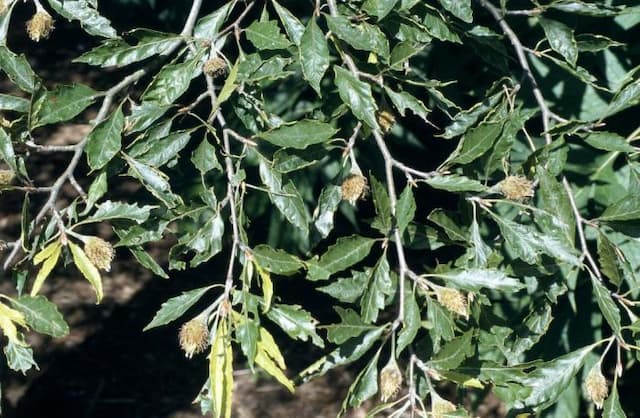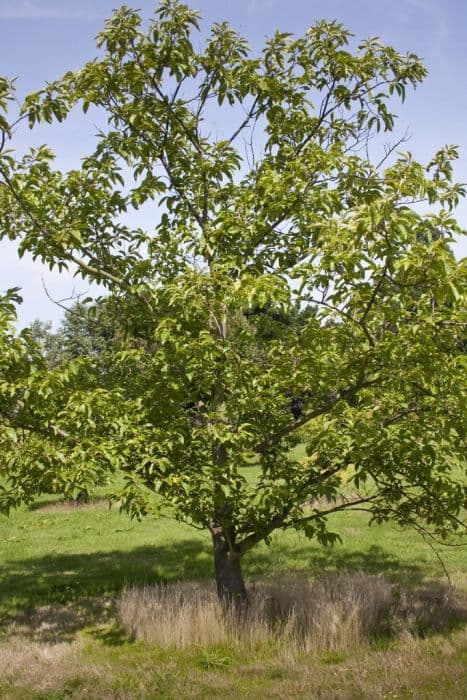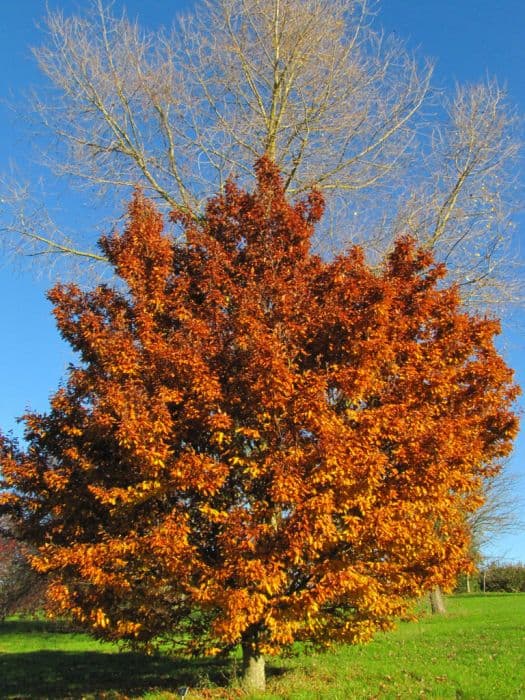European Beech Fagus sylvatica 'Rohan Obelisk'

ABOUT
The Fagus sylvatica 'Rohan Obelisk', commonly known as the European beech, has a distinctive appearance characterized by its narrow and upright shape. Its leaves are unique from other beech varieties, with a crinkled or ruffled texture that adds depth and character to the foliage. The leaves display a rich, purple hue in spring which matures to a deep, burgundy color as the seasons progress. During autumn, the leaves transform once again, this time into a beautiful bronze before they are shed. This variety is also noted for its smooth, grey bark which provides a striking contrast to the colorful foliage. The European beech's compact and columnar form makes it a standout choice for adding vertical accents to landscapes.
About this plant
 Names
NamesSynonyms
European Beech, Rohan Obelisk Beech.
Common names
Fagus sylvatica 'Rohan Obelisk'.
 Toxicity
ToxicityTo humans
The European beech, which is the most common name of Fagus sylvatica 'Rohan Obelisk', is not commonly listed as a toxic plant to humans. Therefore, it is generally considered safe in terms of not having toxins that would cause severe poisoning if ingested. However, caution is always advised as individual sensitivity can vary and the consumption of non-food plants can sometimes cause gastrointestinal discomfort or allergic reactions. Ingesting parts of any non-edible plant might result in symptoms like nausea, vomiting, or diarrhea purely from being an inappropriate food source.
To pets
The European beech is also not commonly listed as a toxic plant to pets. It is generally not considered poisonous to animals such as dogs and cats. However, as with humans, the ingestion of plant material that is not part of a pet's natural diet can lead to digestive upset. If a pet were to ingest parts of the European beech, watch for signs of gastrointestinal distress such as vomiting or diarrhea, and consult a veterinarian if any concerning symptoms arise.
 Characteristics
CharacteristicsLife cycle
Perennials
Foliage type
Deciduous
Color of leaves
Purple-green
Height
40 feet (12 meters)
Spread
10 feet (3 meters)
Plant type
Tree
Hardiness zones
4
Native area
Europe
Benefits
 General Benefits
General Benefits- Compact growth: It has a narrow, columnar form ideal for limited spaces or formal gardens.
- Ornamental leaves: The deep purple, crinkled leaves provide visual interest from spring to fall.
- Low maintenance: Requires minimal pruning and care once established.
- Drought tolerance: Once established, it can withstand periods of dry weather.
- Seasonal interest: Offers year-round interest with its leaf color and texture, as well as its winter silhouette.
- Wildlife habitat: Provides shelter and potential food sources for wildlife such as birds.
- Hardiness: Suitable for a wide range of climatic conditions within its hardiness zones.
- Resistant to pests: Generally resistant to common pests, reducing the need for chemical treatments.
 Medical Properties
Medical PropertiesThis plant is not used for medical purposes.
 Air-purifying Qualities
Air-purifying QualitiesThis plant is not specifically known for air purifying qualities.
 Other Uses
Other Uses- Woodworking Projects: The European beech is valued for its dense, hard wood that can be used in making detailed woodworking projects such as clock cases, puzzles, and small carvings.
- Culinary Smoking: The wood chips of the European beech can be used for smoking meats and cheeses, imparting a delicate, slightly sweet flavor.
- Natural Fabric Dye: Leaves from the European beech can be used to produce a natural green dye for coloring fabrics.
- Photography and Film: The distinct shape and foliage of the 'Rohan Obelisk' cultivar can be utilized in photography and film as a striking backdrop or setting.
- Instrument Wood: The wood of European beech is sometimes used in the manufacture of musical instruments such as drum shells for its resonant qualities.
- Turned Objects: The wood’s fine grain allows it to be turned easily on a lathe, which is ideal for crafting wooden bowls, pens, and other decorative items.
- Furniture Accents: Small branches or unique sections of the tree may be incorporated into furniture design as live-edge accents or inlays.
- Printmaking: The smooth, hard surface of the beech wood is suitable for woodblock or woodcut printmaking techniques.
- Education and Research: Botanical gardens and arboretums may utilize the distinct form of 'Rohan Obelisk' for educational purposes and to study the growth habits of columnar tree varieties.
- Miniature and Model Making: Fine-grain wood like European beech may be used in making detailed miniature furniture and architectural models.
Interesting Facts
 Feng Shui
Feng ShuiThe European beech is not used in Feng Shui practice.
 Zodiac Sign Compitability
Zodiac Sign CompitabilityThe European beech is not used in astrology practice.
 Plant Symbolism
Plant Symbolism- Endurance and Longevity: The European beech, to which Fagus sylvatica 'Rohan Obelisk' belongs, often symbolizes endurance and longevity because of its ability to live for hundreds of years and its sturdy, resilient nature.
- Knowledge and Wisdom: Beech trees have traditionally been associated with knowledge and wisdom. Their towering presence and expansive canopy have been likened to protectors of insight and ancient truths.
- Strength and Stability: The robust structure and extensive root system of the beech tree convey a sense of strength and stability, representing the ability to stand firm in the face of adversity.
- Nourishment and Provision: In history, beech nuts, known as mast, have been a source of food for wildlife and humans, symbolizing nourishment and the provision of resources.
 Water
WaterThe European Beech 'Rohan Obelisk' prefers consistently moist soil, but it is crucial to avoid waterlogged conditions, which can lead to root rot. During the growing season, water the plant deeply once a week, offering approximately 1 to 1.5 gallons per watering session. During hot or dry periods, increase the frequency to twice a week. In winter, reduce watering to every two to three weeks or when the soil feels dry to the touch. Always check the soil moisture before watering and adjust accordingly to maintain even soil moisture without overwatering.
 Light
LightThe European Beech 'Rohan Obelisk' thrives in full sun to partial shade. It is best positioned in a spot where it will receive at least four to six hours of direct sunlight daily. Avoid locations where the plant will be in full shade for the majority of the day, as this can impact its growth and leaf development.
 Temperature
TemperatureThe European Beech 'Rohan Obelisk' is hardy and can withstand a range of temperatures, ideally growing in conditions between 50°F and 80°F. It can survive minimum temperatures down to about -20°F but may be adversely affected at temperatures exceeding 90°F for prolonged periods. Therefore, it is essential to provide a location that offers protection from extreme heat to ensure its health and longevity.
 Pruning
PruningThe European Beech 'Rohan Obelisk' should be pruned for shape and structure, which is best done during late winter or early spring before the onset of new growth. Pruning can also help maintain the tree's health by removing dead, damaged, or diseased branches. Prune this tree every two to three years, and make selective cuts to maintain its columnar form and encourage a strong, central leader.
 Cleaning
CleaningAs needed
 Soil
SoilEuropean Beech 'Rohan Obelisk' thrives in well-drained, moist soil with a slight acidity to neutral pH, ranging from 5.5 to 7. The best soil mix can be prepared with equal parts of loam, peat, and sharp sand to ensure proper drainage and fertility.
 Repotting
Repotting'Rohan Obelisk' European Beech is a slow-growing tree and does not require frequent repotting. It should be repotted every 4-5 years or when it outgrows its current container.
 Humidity & Misting
Humidity & MistingEuropean Beech 'Rohan Obelisk' prefers moderate humidity levels but is adaptable to various conditions. It does not require any special humidity adjustments when grown outdoors.
 Suitable locations
Suitable locationsIndoor
Not suitable for indoor growth due to size.
Outdoor
Plant in well-drained soil, full sun to partial shade.
Hardiness zone
4-7 USDA
 Life cycle
Life cycleEuropean beech 'Rohan Obelisk' begins its life cycle with seed germination, occurring in moist, well-drained soil in partial to full sunlight. The sapling stage follows, characterized by a rapidly growing, columnar form with reddish-purple foliage in spring that matures to a deep purplish-green in summer. As it matures into a young tree, it develops a more pronounced upright, narrow shape, requiring minimal pruning to maintain its form. Reaching maturity after several years, the tree produces small, inconspicuous flowers, followed by triangular beechnuts that provide food for wildlife. The mature European beech 'Rohan Obelisk' has a lifespan of several decades, during which it continues to provide aesthetic value and ecological benefits. Eventually, as the tree enters the senescence stage, growth slows, and it may become susceptible to pests and diseases before eventually dying, completing its life cycle.
 Propogation
PropogationPropogation time
Late Winter to Early Spring
The most popular method of propagation for the European Beech, specifically the Fagus sylvatica 'Rohan Obelisk', is by grafting. This is typically done during the dormant season, from late winter to early spring. In this process, a scion, which is a shoot or bud from the desired beech tree, is attached to a rootstock of another beech, which will provide the necessary support and nutrients. The scion and rootstock are carefully cut to fit together usually in a V-shape or a tongue-and-groove fashion and then secured with grafting tape or wax to protect the joint from disease and drying out. The grafted plant is then allowed to heal and grow, with the rootstock eventually supporting the growth of the desired cultivar 'Rohan Obelisk', which will inherit the characteristics of its scion.
